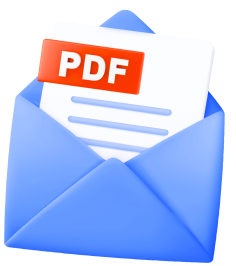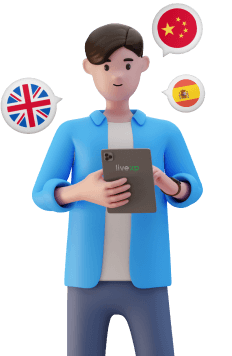
Learn How to Read English Fluently and Enrich Your Language Skills
Reading comprehension is a critical aspect of language learning, so let’s focus on learning how to read English fluently.

Get a FREE guide!
Want to sound like a native English speaker?
Get our free PDF with top tips that work.

Check your email!
In the language-learning realm, we all keep talking about courses, lessons, apps, steps, strategies, tips, and similar. We keep defining the ways to structure the learning path and break the mammoth amounts of work into smaller chunks—and that’s all incredibly helpful. Still, there’s something that doesn’t fit that approach: it’s reading.
To get top-notch language skills, whether it’s in English or your native language, you need to read a lot—not just articles like this one, but also books, from non-fiction to genre bestsellers to classic literary fiction.
You might think the lit fic is too much—classics can be challenging even in your own language, and the internet is full of people who are doing just fine without reading much. But let’s not embrace the line of least resistance. Reading comprehension is a critical aspect of language learning, so let’s focus on learning how to read English fluently.
Why you need to learn how to read English fluently
Before we go to the “how,” let’s begin with the “why.” I’m not the type of person who brags about success, and I’ll never offer anyone to “steal my strategy” on LinkedIn, but I want to use a personal example to show you the connection between strong reading skills and revenue.
I’ll be brief and only share a few facts: English is not my first language, yet I’ve made a career as a creative writer in English, and I’m doing better than many natives. My love for books and a degree in literature opened up some great job opportunities for me. I’ve been repeatedly hired to read large books so my clients and their audiences wouldn’t have to. This experience has honed my skills and will hone yours, too.
Learn how to read English—setting the right mindset for beginners
Since you’re reading this, you’re definitely not a complete beginner, but you may still be intimidated by the thought of opening a literary masterpiece and facing a language that’s not nearly as plain as the stuff you can read online. But there’s no reason to fear those books. You can learn how to decode them and enjoy the process.
The underlying process is quite complex, and it involves maintaining your focus, using your memory, gathering clues, reckoning, visualization, and other mental activities. But, we are usually not aware of all those processes as we read. That’s because our brain is designed to do many things simultaneously—in any language we know. We’re born with that power, and there’s no good reason not to use it.
When we look at the reading process from another angle, there are several levels of reading comprehension: the literal level and the deeper one, which demands closer attention from our end. They call us to use our capacity for interpretation and critical thinking.
We constantly seek meaning. Our cognitive processes are always at work, interpreting content across various contexts—whether it involves translating text from a foreign language or identifying subtle, hidden messages within texts written in our familiar language. Those skills are essential for self-improvement, which is another reason to put even more time and effort into practicing reading comprehension in English.
Reading books📚 to help improve reading comprehension
When it comes to picking a book for your reading comprehension practice, the right choice depends on your current level. But don’t sell yourself short: always aim for a level above your current one, and make the task at hand a bit challenging.
If you’ve never read long-form content in English and this whole thing still looks too hard, start with a book you’ve already read in your first language. Diving into a familiar book and rereading it in English can really help with getting a grip on the language. When you already know the plot and characters, it’s less about figuring out the story and more about understanding the words and how they’re used. Plus, there’s something comforting about reading a book you love, and it definitely boosts your confidence.
If this sounds too ambitious, you can start with a graded reader online or find a book created with ESL students in mind. I can recommend Short Stories in English for Beginners by Olly Richards, as that’s what my 10-year-old kid is reading right now, so I had to read it first. The author uses the most frequently used words in English to create compelling stories that you can understand. It does include a small number of potentially unfamiliar words, but the book comes with a built-in dictionary, so a correct and fitting definition of each term is just a click away (that’s in the ebook; in the printed one, I guess you can find those words in the footnotes). There are also many other similar books that I think may be great, but I haven’t had a chance to review them.
For the more experienced and courageous, there are endless lists of great books everywhere—no need for me to make you one. Choose a highly-rated title in your favorite genre or category, and give yourself enough time to adjust and enjoy the content.
Regardless of your level, I would recommend reading fiction, as it transports you into another realm and keeps you engrossed, which makes the deciphering process seem effortless. The first book I read from cover to cover in English after university (so it was my choice completely) was 1Q84 by Haruki Murakami (OK, that one was translated from Japanese, and I could have chosen a book originally written in English, but really—that doesn’t matter). I started reading it and couldn’t put it down, except for taking breaks for vital activities like eating and sleeping. I probably missed some nuances back then, but who cares? I loved it, and it made reading any subsequent book easier.
If you’re not into fiction and don’t want to read stories, there are also fantastic non-fiction books in all bookstores and libraries. Just avoid dry textbooks or anything about a topic you know very little about. Obviously, it would help if you don’t read in English content that would be challenging even in your first language. Instead, you can take a self-development book that talks about life in general but frames the familiar stuff differently.
The way you read may vary based on how you usually read in your first language. If you pick fiction, and you happen to love the novel, you’ll probably read it fast, excited to uncover the whole story. Non-fiction, though, may demand taking notes and summarizing every chapter before you get to the next one.
Now, you’re probably thinking about finding and reading existing summaries online to facilitate your understanding of the book. Using them could be helpful, but I would be careful with that. Those summaries, if they are good (which is often not the case), can be incredibly useful if you need information on a certain book quickly. But if you started thinking—oh, I’m new to reading English content, so I should read summaries instead of books—please don’t. When someone digests a book for you, you only get the result of their mental effort, which you can memorize if you wish, but that’s all. You miss the chance to process the ideas naturally.
Authors usually use multiple ways to communicate their important thoughts. They repeat and rephrase them several times throughout the book so that they may stick to the reader’s mind. They also often use examples to illustrate their points. When you read a book chapter, you get a chance to grasp those ideas almost intuitively. But if you turn to a summary, you’ll only get a couple of sentences for each concept, and the only mental ability you’ll get to use and enhance will be memorization.
💡Helpful tips and tools for reading practice
As you read, you’ll often come across unfamiliar words, idioms, and grammar patterns. It’s essential to understand most of them before moving on, but without spending too much time on every detail.
A traditional way to handle this challenge is to write down any word or phrase you don’t understand, then look it up in a dictionary, and then promise yourself you’ll revisit the list and practice those words later. This approach works for some people but not for everyone. Many get so discouraged by the rapidly growing list that they eventually stop adding to it. Unfortunately, such minor setbacks can harm your motivation. It’s essential to be aware of this potential pitfall and try to avoid it.
Luckily, there is also an easy and pleasant way to process all those words. LiveXP’s developers have created a feature within the app that you can use to amplify your vocabulary learning journey. It is called Word Trainer, and it is incredibly helpful. You get to enter all those unfamiliar words as they appear, and the app does the rest—provides a translation and creates spaced repetition flashcards for you.
So, once you enter the words you struggle with in the app, you can practice them later whenever you have 5-10 minutes free and your phone in your hand.
Spaced repetition is a scientifically backed approach that ensures long-term retention of information by exposing learners to it at increasing intervals. It’s like flexing your memory muscles just when they start to forget, strengthening the information each time. LiveXP’s Word Trainer capitalizes on this principle. When you add a new word to “My Vocabulary,” the app ensures you review it optimally, helping to cement it in your long-term memory.
Imagine you’re nestled in your favorite reading nook, engrossed in an English novel, and suddenly, a wild, unfamiliar word appears. You might scribble it down in a notebook or perhaps skip over it, but with LiveXP, you have a powerful companion at your fingertips. Simply open the “My Vocabulary” section of the app, type in the word, and voilà! The translation appears. With a tap, you can add this new word to your digital vocabulary list, ensuring you never lose track of the words you want to master.
From digital learning🤖 to human interaction🧑🏽💻
While apps offer unparalleled convenience, the true essence of language lies in its conversational application. This is where LiveXP’s vast network of tutors comes in. The platform offers 1-on-1 lessons, enabling you to practice new vocabulary in real-life conversations. Think of these sessions as a safe space to make mistakes, ask questions, and receive feedback.
When it comes to practicing reading comprehension, LiveXP allows you to dive deep into book discussions with your tutor, integrating newly learned words in meaningful dialogues about narratives and themes.
Some texts rely heavily on cultural knowledge that might not be immediately evident to ESL readers. Discussing confusing sections with native speakers can provide new insights and help you decipher the author’s intentions. Also, talking about what you’ve read solidifies comprehension and introduces new viewpoints.
Whatever you read, talking about the text with others will deepen and broaden your understanding. Different viewpoints can shed new light on the material. In addition to discussing books with a tutor, you can partner with a fellow ESL learner. Read the same material and provide feedback on each other’s comprehension.
To further capitalize on this collaborative learning, consider forming a study group. Engaging in group discussions can introduce a plethora of interpretations, ensuring that every nuance is captured and discussed. This not only deepens your grasp of the content but also fosters a sense of community in your learning journey.
If the idea of a study group feels overwhelming or isn’t feasible, don’t be discouraged. Discussing a book or material with just one person can be just as fruitful. Whether it’s a friend who shares your reading interests or a tutor who can guide you through the complexities, having a dedicated individual to converse with is all you need right now—in addition to a great book to read, of course.
Crafting a routine to learn how to read English fluently
Creating a routine to adopt new learning patterns is a sure way to continue advancing. Here’s a simple routine you can adopt:
- Read great stuff: Don’t let a day pass without reading for at least an hour. If you find that challenging or you lack motivation—change the book.
- Daily vocabulary logging: While reading or going about your day, add unfamiliar words to My Vocabulary.
- Use Word Trainer: Dedicate a few minutes daily to review words using the spaced repetition approach.
- Engage with a tutor: Schedule weekly or bi-weekly sessions on LiveXP to practice new vocabulary in fluid conversations.
Keep in mind that reading should be a pleasant activity. Pick your books wisely. You don’t have to stick with one that doesn’t spark your interest—there are plenty of those that you’ll love.
There’s real treasure out there. Try Amazon Unlimited or browse the list of timeless classics on Project Gutenberg. Ask your friend or tutor for a recommendation. Join reading forums. After a while, you can start a book blog to review the books you’ve read and recommend the best ones to your readers! Now, it is time to start reading and enjoy the journey.
















